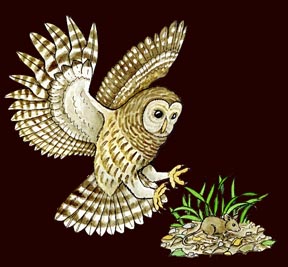

Cathy from Kentucky asks: "We know that owls have good eye sight for hunting at night, but do they also have good hearing and/or smelling?"
Owls don't have an outstanding olfactory sense (that's smell), but they do have very good hearing. Many species of owl have ears that are slightly offset, with one ear higher than the other. This helps them locate the slightest rustle in the leaves, so they can fly on silent wings and snag prey. Their rounded faces (facial disc) help direct sound into their ears, which are just holes in the sides of their heads, unlike the human ear. Their vision is also good, with large eyes and binocular vision, but because they hunt in the dark, owls depend a lot on their sense of hearing to find prey.
When you research information you must cite the reference. Citing for websites is different from citing from books, magazines and periodicals. The style of citing shown here is from the MLA Style Citations (Modern Language Association).
When citing a WEBSITE the general format is as follows.
Author Last Name, First Name(s). "Title: Subtitle of Part of Web Page, if appropriate." Title: Subtitle: Section of Page if appropriate. Sponsoring/Publishing Agency, If Given. Additional significant descriptive information. Date of Electronic Publication or other Date, such as Last Updated. Day Month Year of access < URL >.
Amsel, Sheri. "The Special Sense of Owls" Exploring Nature Educational Resource ©2005-2024. December 13, 2024
< http://www.exploringnature.org/db/view/The-Special-Sense-of-Owls >
